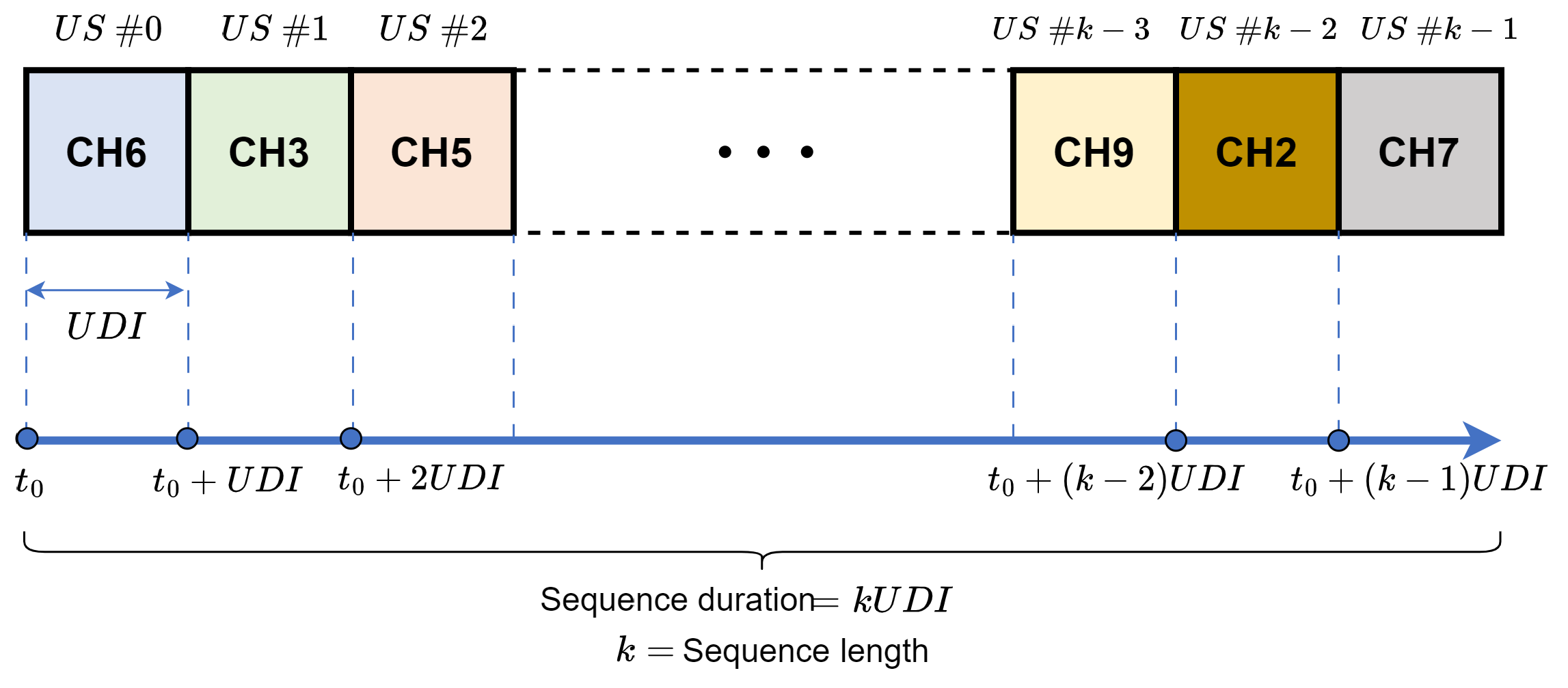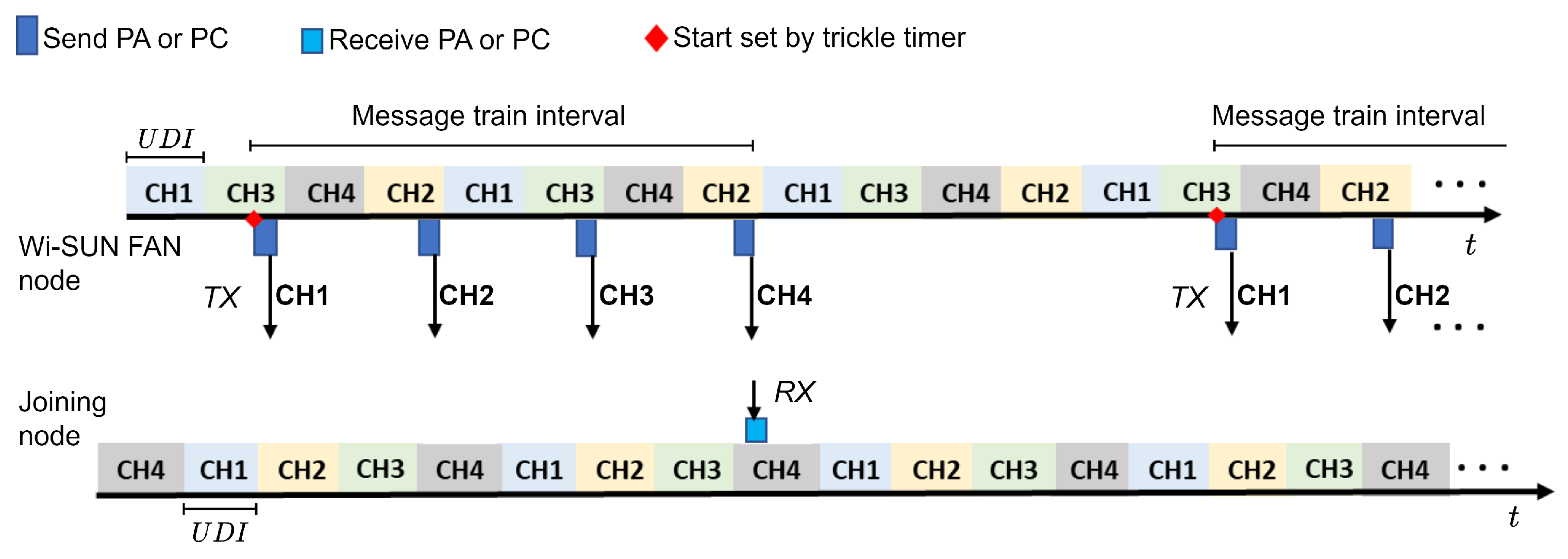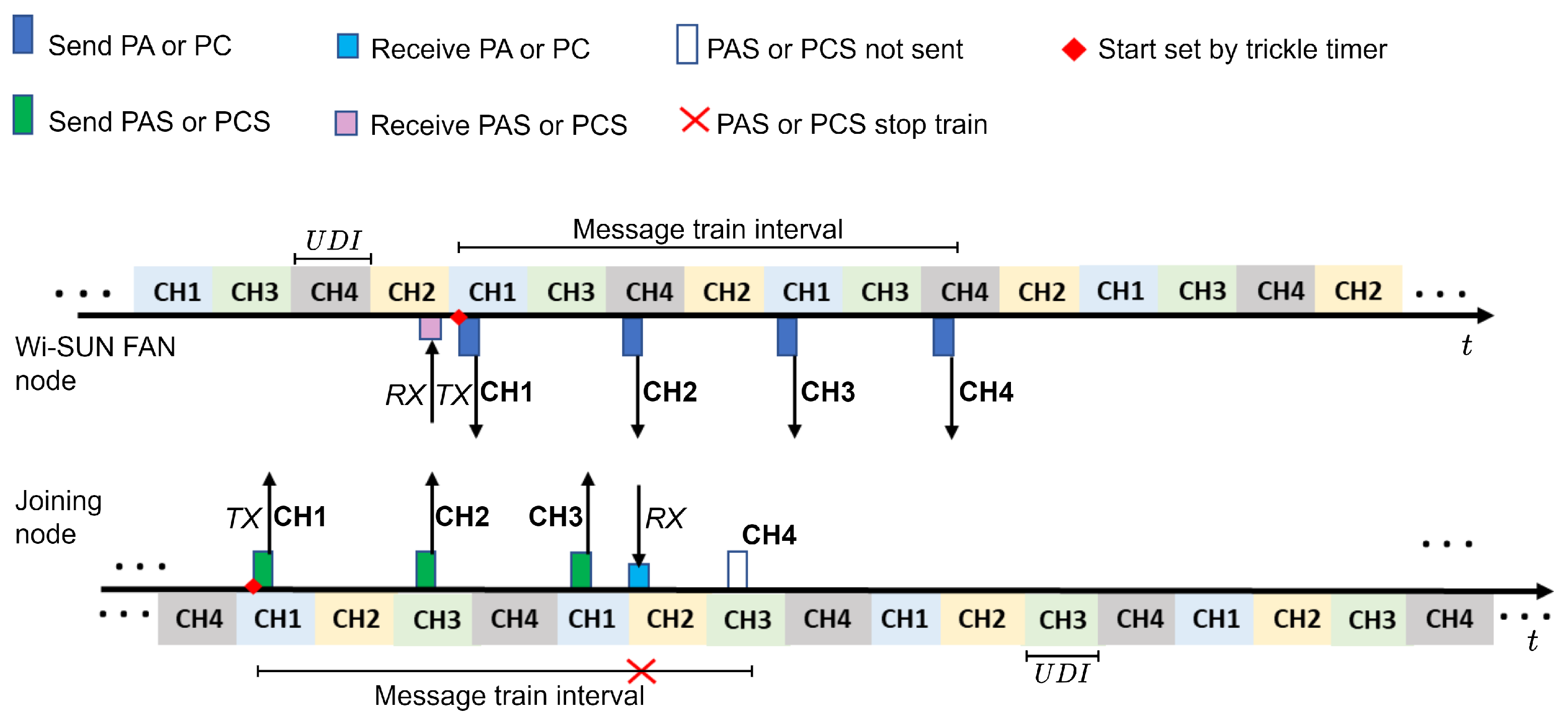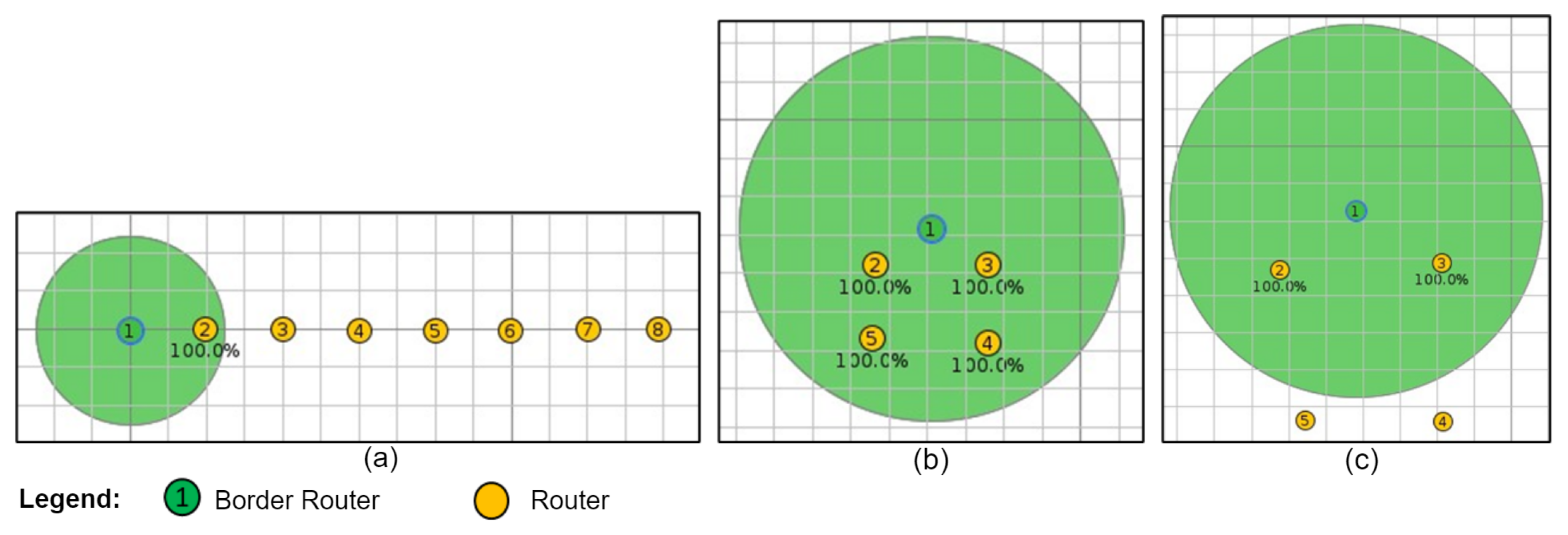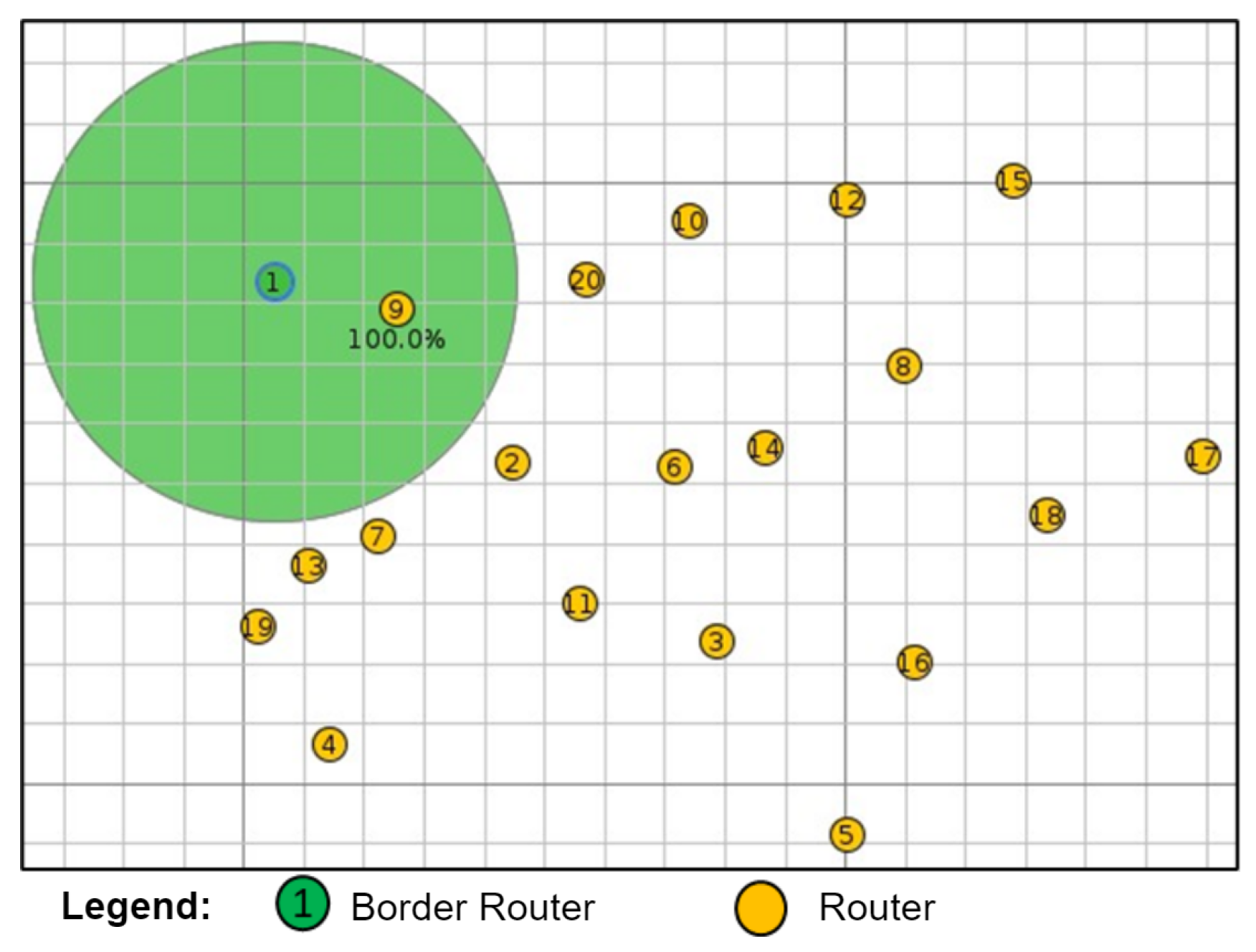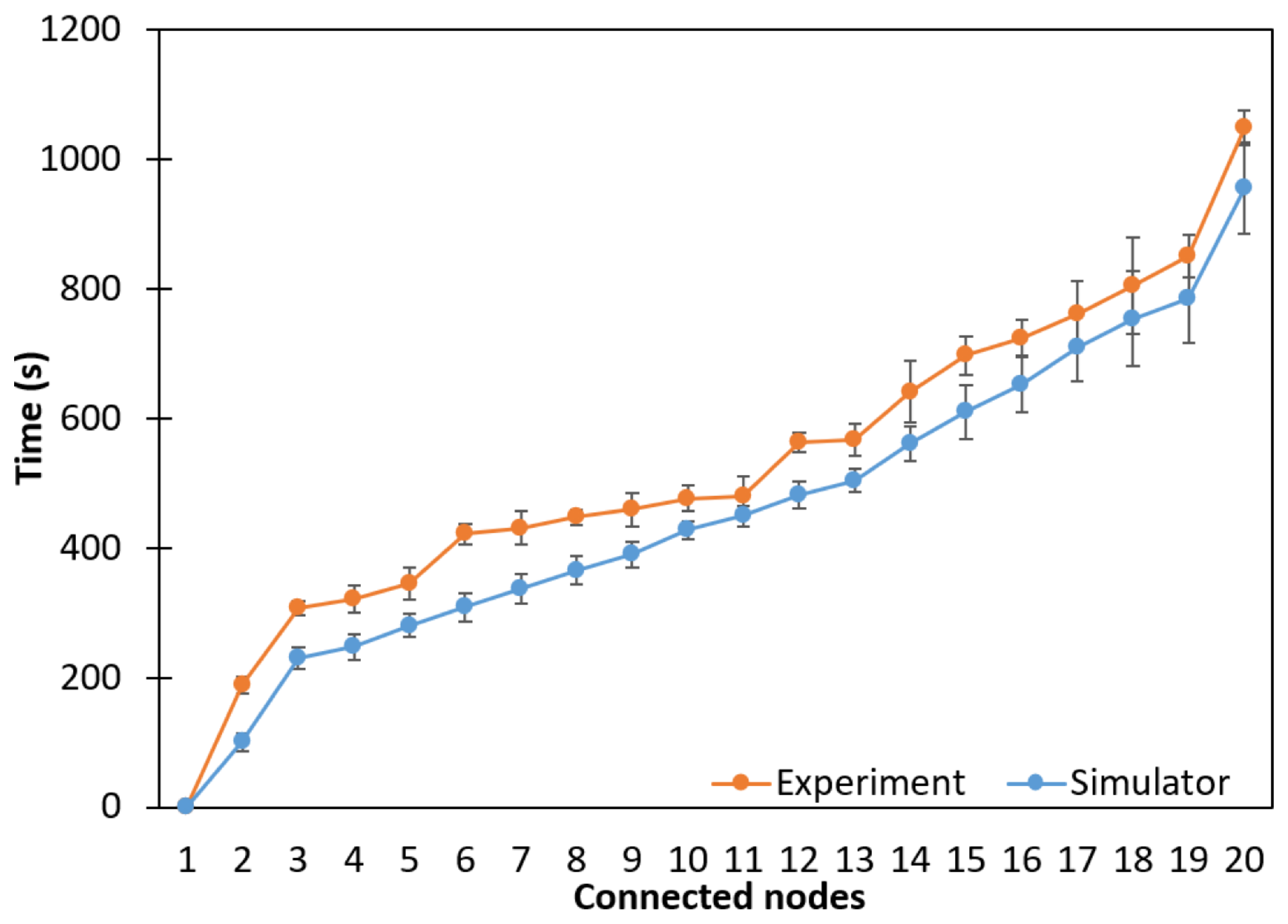1. Introduction
Wi-SUN FAN, an open protocol-based wireless communication standard for low-power and lossy networks (LLNs) [
1], is gaining attention in various applications, such as smart meters, smart cities, and the Internet of Things (IoT) [
2], where thousands of nodes are interconnected [
3,
4]. The standard, part of the Wi-SUN Alliance [
5], is characterized by its mesh network configuration with multihop communication utilizing the RPL protocol [
6,
7] that enables dynamic network formation, thereby offering higher data rates, frequency hopping to prevent interference, and interoperability among different manufacturers [
1]. However, certain security aspects need flexibility on the provider’s side [
8], and the ecosystems for upper layers are yet to be defined [
9].
Special attention must be given to the process of connecting nodes to the network, which encompasses node discovery, merging, and network formation. Previous experimental work [
10] revealed slow connection times in multihop networks, thus prompting investigations into the parameter settings of the trickle timer algorithm [
11]. While Wi-SUN FAN documentation provides parameter recommendations [
1] for small and large networks, experimental evaluations [
12] indicate persistently high connection times, especially in large network configurations.
To achieve the full performance predicted by the standard, some device manufacturers and other researchers have conducted experiments in controlled environments with up to 100 devices [
12,
13,
14]. These experiments emphasize the importance of configuring parameters based on network size to balance connection time, latency, and device scalability. Other works involving a smaller number of devices, such as those in [
15], conducted performance evaluations in an urban setting, thus utilizing a maximum of three devices. The findings affirmed commendable performance in terms of packet success rate and latency within an urban scenario. Furthermore, [
16] assessed the data flow in various advanced metering infrastructure (AMI) applications using a maximum of seven devices, thus affirming the Wi-SUN FAN’s capability to effectively support diverse intelligent network applications.
Based on the results above, it can be seen that the information available for evaluating the performance of the Wi-SUN FAN is still insufficient, since the application of an experimental methodology for this purpose is time-consuming, and its cost increases with the number of devices. Consequently, other alternatives such as computer simulation are needed to reproduce the behavior of the standard in order to allow for a quick performance analysis in different scenarios and with different parameterizations.
With this perspective, some works were published that were focused on the development of simulators and emulators to evaluate the performance of the Wi-SUN FAN. For instance, in [
12], Silicon Labs presented simulation results using the stack already developed for their devices and created internal tools that run multiple instances of the Wi-SUN FAN stack for the simulated nodes; therefore, this simulator is confidential. Additionally, in [
17,
18], emulators were proposed in order to address the performance of the Wi-SUN FAN at the physical layer, with the results obtained being focused on the transmission characteristics in large-scale networks; therefore, these emulators are not suitable for implementing new algorithms in other layers of the standard.
In this paper, the process of joining nodes to Wi-SUN FAN networks is implemented using Contiki-NG, an open source operating system (OS) that is compatible with a wide range of wireless sensor network hardware, which provides protocols libraries for smart devices [
19] in low-power networks that can be configured and tested using the Cooja simulator for different network scenarios. In this way, different available protocols [
20,
21] that have been used to facilitate the implementation of the Wi-SUN FAN standard can be leveraged, in particular the RPL protocol that is used for network formation and allows for the implementation of the node connection process that goes through the join states in the Wi-SUN FAN [
1].
The implementation of the standard is done mainly in the medium access control (MAC) layer of the Contiki-NG stack, where two main processes are configured, such as the node discovery and joining process, using the MLME-WS-ASYNC-FRAME technique [
1] and frequency hopping procedures. These procedures enable the implementation of asynchronous, unicast, and broadcast communication of the Wi-SUN FAN standard. In this sense, we added a feature to Contiki-NG that allows for a quick performance evaluation of Wi-SUN FAN network scenarios, thereby providing easy scalability of the number of nodes in different network topologies and allowing the use of fewer resources compared to experimental work.
The main objective of this work is to develop a simulation tool that allows for evaluating, from a temporal point of view, the connection process of the nodes in Wi-SUN FAN networks. In particular, regarding the long connection time of the Wi-SUN FAN nodes, the functionality being proposed will make it possible to quickly simulate the process of discovering, joining, and forming the network, which will facilitate the implementation of new techniques to reduce the network formation time. Thus, our main contribution is the following:
The remainder of this paper is structured as follows.
Section 2 describes some technical background information about Wi-SUN FAN networks.
Section 3 describes the structure of the simulator. In
Section 4, the proposed solution is validated for each scenario studied, while
Section 5 presents the results. Finally,
Section 6 concludes the paper.
2. Background Information
The Wi-SUN FAN is a standard that belongs to the Wi-SUN alliance [
22] solution profile list and is intended for various applications for large-scale outdoor networks.
Figure 1 shows the different layers that make up the standard [
1], where the physical layer is based on the IEEE802.15.4 [
23] protocol, and the frequency band used is regulated according to the region of operation. Regarding the data link layer, the MAC sublayer is defined in the IEEE802.15.4 protocol and uses frequency hopping, and the LLC (logic link control) sublayer uses the optional L2 mesh service. At the network layer, the IPv6 over low-power wireless PAN (6LoWPAN) adaptation is used for the network service, and for the network formation, it uses the RPL protocol, where the Internet Control Message Protocol for IPv6 (ICMPv6) is used for its control packets. Finally, the transport layer supports the User Datagram Protocol (UDP) and Transmission Control Protocol (TCP) packet traffic. The upper layers of the OSI model (application, presentation, and session) are not part of the Wi-SUN FAN protocol stack.
A Wi-SUN FAN network is hierarchical and consists of three types of nodes: a (a) border router (BR), which manages all source routing information for the other nodes; a (b) router (R), which is the node that handles the upward and downward forwarding of packets and maintains the routing tables for its neighboring nodes; and a (c) leaf (F), which is the node that provides the minimum capabilities for discovering and entering the PAN, as well as sending and receiving packets.
2.1. Frequency Hopping
The nodes support channel hopping over a pseudorandom sequence defined by the channel function for unicast and broadcast transmissions [
1,
24,
25,
26,
27]. Unicast frequency hopping is receiver-directed, with the unicast hopping sequence derived from the node’s MAC address and the set of available channels [
13].
Figure 2 shows the unicast frequency hopping, where the hopping sequence can be thought of as a repeating sequence of a UDI or unicast slot (US), where the US number identifies a specific location in the sequence.
Figure 3 shows the broadcast frequency hopping, where the hopping sequence can be thought of as a repeating sequence of broadcast intervals (BI) or broadcast slots (BS), with the BS number denoting a specific location in the sequence. The broadcast dwell interval (BDI) is usually much shorter than the BI.
2.2. Discovery and Joining of Nodes
An RB and at least one R or F node are required to establish a Wi-SUN FAN network. Any node wishing to join a PAN must go through five join states [
1,
10,
24]: (i) Join State 1 (JS1)—the discovery process of available PANs and asynchronous communication through the PA (PAN Advertisement) and PAS (PAN Advertisement Solicit) messages; (ii) Join State 2 (JS2)—the node authentication process (in this work, this process was not implemented in this simulator due to its high complexity); (iii) Join State 3 (JS3)—the PAN configuration data collection process and asynchronous communication through the PC (PAN Configuration) and PCS (PAN Configuration Solicit) messages; (iv) Join State 4 (JS4)—the node routing configuration process using the RPL protocol; and (v) Join State 5 (JS5)—the node is then part of the Wi-SUN FAN network.
Figure 4 shows the discovery and joining process in a simplified form, thereby mainly showing the exchange of messages between JS1 and JS3.
When a node is discovered, the Wi-SUN FAN uses the MLME-WS-ASYNC-FRAME mechanism to transmit association messages, which is a service described in [
1] that is an equivalent to the MLME (MAC sublayer management entity) services [
23]. This process starts in JS1, where an RB or other R nodes already connected to the network announce the existence of the network by periodically broadcasting PA messages with the minimum parameters for a new node so that the new node can choose from several available PANs.
Figure 5 shows an example with an announcement node and a joining node that start listening to a sequence of four channels. Note that the sequence of channels is different for each node and that they start at different times. The dwell time on each channel is defined by the variable UDI, and the number of PA messages is determined by the number of available channels. The packets are sent sequentially according to the list of available channels, starting with the first one (in our example, from CH1 to CH4). Once the sequence of PA messages is over, it waits until the next start time, which is determined by the trickle timer. In this example, the joining node receives the PA packet on CH4.
In addition, joining nodes can force the PA to be sent by its neighbors (before the time designated by the trickle timer) by sending PAS messages.
Figure 6 illustrates the process of sending the PAS message train to speed up the sending of PA messages. When the advertising node receives a PAS, it triggers the start of the PA message train. The joining node that receives a PA interrupts this process when it is in the process of sending a PAS message train.
In JS3, PC messages are transmitted in encrypted form when a wide network configuration is shared. As in the PA, PC transmission is controlled by the trickle timer as shown in
Figure 5, and the joining node can force transmission (before the time scheduled by the trickle timer) by transmitting PCS messages as shown in
Figure 6.
Therefore, this node association process is governed by the trickle timer algorithm [
11], which defines the time intervals for sending these control messages (PA, PAS, PC, PCS). The Wi-SUN FAN documentation shows configuration recommendations on this algorithm, thereby defining mainly two configurations: small and large networks. In [
12], manufacturers consider a network with 1 to 100 devices to be small, while networks with more than 800 devices are considered large networks. They also consider a configuration of medium networks when the number of devices is between 100 and 800. In the association process, these configurations have an important impact on the relationship between the connection time, latency, and scalability of the network. A consideration to take into account with the Wi-SUN FAN standard is to choose the type of configuration according to the type of application.
3. Implementing the Wi-SUN FAN Node Association Procedure in Contiki-NG
In this section, we describe the implementation, within the Contiki-NG stack structure, of a functionality that allows for evaluating the process of connecting nodes to Wi-SUN FAN networks.
Figure 7 shows the added mechanisms, where frequency hopping and the MLME-WS-ASYNC-FRAME association mechanism are added to the MAC layer. Unlike
Figure 1, the order of use of the protocols using the Cooja simulator is shown. On the other hand, the CSMA-CA (carrier-sense multiple access with collision avoidance) and RPL files were adapted to take into account the frequency hopping process of the Wi-SUN FAN.
The main reason for using the Cooja simulator is that it has allowed us to replicate the scenarios used in the experiments, where each node is a compiled and executed Contiki system. In addition, it has an interface to analyze and interact with the nodes; this makes it possible to capture messages from the simulations and facilitates the visualization of the network. It is also possible to create custom scenarios [
28].
The channel hopping functionality is implemented according to the technical information described in
Section 2.1; this functionality is added to a folder called ‘wisun-mac/’, which is located inside the ‘net/’ folder of the Contiki-NG stack. The MLME-WS-ASYNC-FRAME association functionality is implemented as described in
Section 2.2, which is placed in the same folder as the previous functionality. For the nodes to follow the association process of a Wi-SUN FAN network of
Figure 4, two types of nodes with BR and R characteristics are generated; in the simulator, they are the files “border-router.c” and “router.c”.
The association process of these nodes with these two functionalities are implemented in the Algorithm 1. A node performs a channel scan call () by listening to the PA and PC packets on the available channels in the V (the vector containing the channels available for the network), one by one in the order of their occurrence in V, using a round-robin procedure, thus starting on a random channel given by a channel function.
The nodes initialize the following variables: the number of channels available (), which can be used to scale the number of channels for V; the channel index (), which is used to select the channel within V; and the channel scan time (), which sets the scan time for each channel (lines 1–3 in Algorithm 1). The vector V is generated by the channel function, and is set to the value 0 to start a scan in the first channel of the vector V (lines 4–5 in Algorithm 1).
When the nodes are in JS1 and want to connect, they listen to each channel for a period of time specified by the . Nodes select a channel present in the V each time they change the currently scanned channel using the round-robin strategy; that is, increases by 1 (lines 6–13 in Algorithm 1). As soon as the unassociated node hears a PA, it extracts the unicast communication timing information from the Wi-SUN FAN node and, as JS2 was not implemented in the simulator, the node jumps to JS3 (lines 14–16 in Algorithm 1).
In JS3, the node performs the same process as before by listening to each channel of the
V for a period of time specified by the
and performing a round-robin scan (lines 19–25 in Algorithm 1). Once the nonassociated node listens to a PC, it extracts the information from the broadcast communication to get to JS4 (lines 26–28 in Algorithm 1).
| Algorithm 1 Wi-SUN FAN association |
- 1:
: number of available channels - 2:
: channel index - 3:
: channel scan time - 4:
← channel_function() - 5:
← 0 - 6:
if node = JS1 then - 7:
- 8:
while is not associated do - 9:
if the scan time has expired then - 10:
resets the scan time - 11:
- 12:
- 13:
end if - 14:
if PA is received then - 15:
node ← JS3 - 16:
end if - 17:
end while - 18:
end if - 19:
if node = JS3 then - 20:
while is not associated do - 21:
if the scan time has expired then - 22:
resets the scan time - 23:
- 24:
- 25:
end if - 26:
if PC is received then - 27:
JS4 - 28:
end if - 29:
end while - 30:
end if
|
At the end of the process described in Algorithm 1, the Contiki-NG functionalities are used. The CSMA-CA protocol for channel access and the RPL protocol for network formation are used for JS4. Finally, the node enters JS5.

